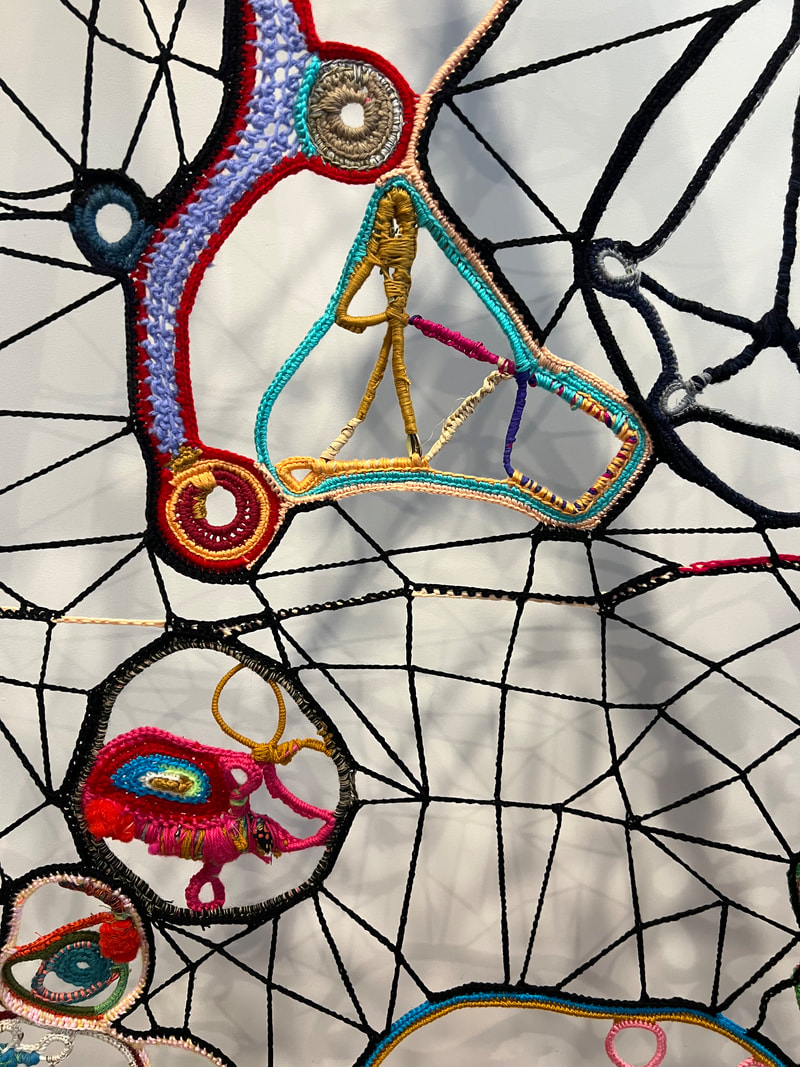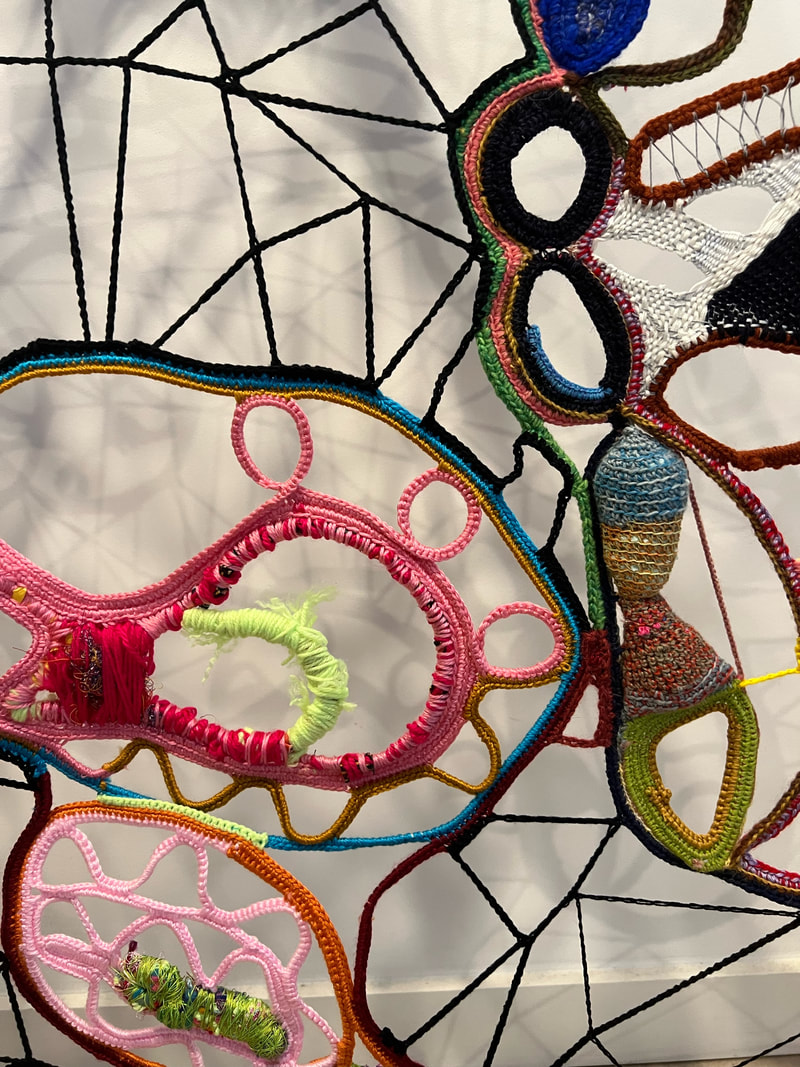Chinkana 2023
My work Chinkana was created as part of the Yarn for hands project led by Yunuen Perez. Yarn for hands is an exhibition by 6 artists from the Latin American diaspora as a bold response to the impact of fast fashion vs a slow-time approach to textile-making. By reconnecting to the experiential tactility of working directly with yarn and recyclable materials, the newly commissioned artworks invite the visitor closer to the aesthetic impact, technical skills and powerful storytelling capacity of textile art.
The exhibition is curated by Yunuen Perez. The artists are Carla Risco, Carmen Novoa, Isabel Avendano-Hazbun, Paula do Prado, Viviana Arango and Yunuen Perez. Yarn for Hands was part of Craft Contemporary 2023. Find out more here www.melbourne.vic.gov.au/community/libraries/whats-on/exhibitions/Pages/yarn-for-hands.aspx and follow Yarn for Hands on instagram @yarnforhands
The exhibition is curated by Yunuen Perez. The artists are Carla Risco, Carmen Novoa, Isabel Avendano-Hazbun, Paula do Prado, Viviana Arango and Yunuen Perez. Yarn for Hands was part of Craft Contemporary 2023. Find out more here www.melbourne.vic.gov.au/community/libraries/whats-on/exhibitions/Pages/yarn-for-hands.aspx and follow Yarn for Hands on instagram @yarnforhands
Paula do Prado, Chinkana 2023, (detail)
Various recycled, gifted and new cotton, wool and synthetic yarns, fabric scraps, thread offcuts, raffia, Lomandra, felt, triangular steel frame. 240 x 160 x 50cm freestanding.
Various recycled, gifted and new cotton, wool and synthetic yarns, fabric scraps, thread offcuts, raffia, Lomandra, felt, triangular steel frame. 240 x 160 x 50cm freestanding.
Artist Statement
As a very young child, as soon as I could hold a pencil, I would draw. My mother says I would sneak a pencil into my cot bed and she would later find tiny pencil drawings on the wall, little stick figures and squiggles. My early years until the age of 7 before we migrated to Australia were spent in Montevideo, Uruguay where I was born on the lands of the Charrúa Nation. It was the early 80s and I grew up in a poor urban neighbourhood. My parents say I was an easy quiet child and I was happily entertained by being given a piece of paper and colouring pencils. I remember I would sometimes ask my dad to draw me a paper doll that I could cut out to play with but what I remember most is my dad drawing me mazes to solve. I loved solving the mazes. I also loved watching my dad intently as he would draw the mazes and they would get increasingly more intricate and therefore difficult to solve. I’ve repeated this practice with my young son Tomas, but it is he who now draws mazes for me. I always found it pleasurable to both design and solve mazes. I feel a similar way when I am weaving, although the designing and problem solving seem to happen in tandem. I am in a constant push and pull between feeling for where to place the next thread or line and what that placement will mean for the next line or form and so on. When I am weaving, I encounter multiple pathways and multiple possible solutions. It is not a physical maze that I enter but a psychic space, the creative imaginal or what some might call ‘the zone’. The labyrinth for me is an apt metaphor for the creative process where enthusiasm, the creative spark, disappointment and doubt all reside. My sense of curiosity almost always overrides whatever fear of failure or doubt I might have. Nonetheless, every artwork represents what can be an uncomfortable inward journey through the labyrinth to emerge changed on the other side.
Chinkana is a Quechau word for labyrinth. My creative art practice in all its haptic connections with thread and yarn, sentipensante (feel-thinking) ways of making, doing and being are all grounded in rich Abya Yala soil. Chinkana represents all the above and below ground labyrinths I navigate, the real and psychic subterranean tunnels carved into my ancestral marrow so that I could always find my way home. This artwork was developed over a period of 6 months in companionship and exchange with five other artists of Latin American origin. This work is not a representation of the lone protagonist’s heroic quest. It is for me at least, a visual representation of a collective journey into the labyrinth. The six of us descended into the dark belly of the pyramid and emerged together, each walking our own paths, questioning, encouraging and bearing witness to each other’s journeys. I am excited to see what our creative works might say in conversation as part of this exhibition. How these works might speak to the time we are living in and our lived realities as migrants making home on unceded lands.
As a very young child, as soon as I could hold a pencil, I would draw. My mother says I would sneak a pencil into my cot bed and she would later find tiny pencil drawings on the wall, little stick figures and squiggles. My early years until the age of 7 before we migrated to Australia were spent in Montevideo, Uruguay where I was born on the lands of the Charrúa Nation. It was the early 80s and I grew up in a poor urban neighbourhood. My parents say I was an easy quiet child and I was happily entertained by being given a piece of paper and colouring pencils. I remember I would sometimes ask my dad to draw me a paper doll that I could cut out to play with but what I remember most is my dad drawing me mazes to solve. I loved solving the mazes. I also loved watching my dad intently as he would draw the mazes and they would get increasingly more intricate and therefore difficult to solve. I’ve repeated this practice with my young son Tomas, but it is he who now draws mazes for me. I always found it pleasurable to both design and solve mazes. I feel a similar way when I am weaving, although the designing and problem solving seem to happen in tandem. I am in a constant push and pull between feeling for where to place the next thread or line and what that placement will mean for the next line or form and so on. When I am weaving, I encounter multiple pathways and multiple possible solutions. It is not a physical maze that I enter but a psychic space, the creative imaginal or what some might call ‘the zone’. The labyrinth for me is an apt metaphor for the creative process where enthusiasm, the creative spark, disappointment and doubt all reside. My sense of curiosity almost always overrides whatever fear of failure or doubt I might have. Nonetheless, every artwork represents what can be an uncomfortable inward journey through the labyrinth to emerge changed on the other side.
Chinkana is a Quechau word for labyrinth. My creative art practice in all its haptic connections with thread and yarn, sentipensante (feel-thinking) ways of making, doing and being are all grounded in rich Abya Yala soil. Chinkana represents all the above and below ground labyrinths I navigate, the real and psychic subterranean tunnels carved into my ancestral marrow so that I could always find my way home. This artwork was developed over a period of 6 months in companionship and exchange with five other artists of Latin American origin. This work is not a representation of the lone protagonist’s heroic quest. It is for me at least, a visual representation of a collective journey into the labyrinth. The six of us descended into the dark belly of the pyramid and emerged together, each walking our own paths, questioning, encouraging and bearing witness to each other’s journeys. I am excited to see what our creative works might say in conversation as part of this exhibition. How these works might speak to the time we are living in and our lived realities as migrants making home on unceded lands.


